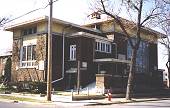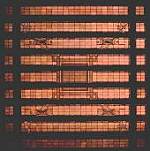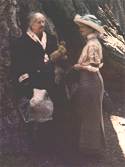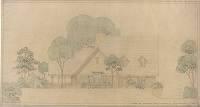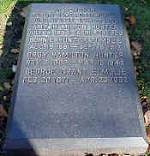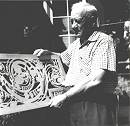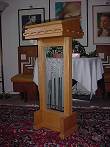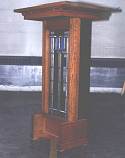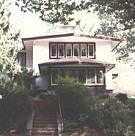|
|
|
Purcell and Elmslie, Architects Firm active :: 1907-1921
Minneapolis, Minnesota :: Chicago,
Illinois |
Ye Older Grindstones
5/19/2003
Stewart Memorial Church, now Redeemer Missionary Baptist Church, pre-restoration
Merchants Bank original skylight, 1914
The Purcell family vacation to California, 1915
Detail: Catherine Gray (left) and Edna Summy Purcell (right), 1915Helping hands. One of the most amazing things--long and enduring struggle it was--that I've ever witnessed is the restoration of the former Stewart Memorial Church, now Redeemer Missionary Baptist Church, in Minneapolis. Originally intended as a "mission" church, the structure served a prosperous middle class neighborhood when built and continued to do so for decades. The construction of the interstate freeway missed the church by fifty feet (whew), but the impenetrable barrier of the road was a death blow to the surrounding community--as all things to do with the "urban removal" of the 1950s generally were. The church struggled on with various efforts by the Presbytery, including drug rehabilitation programs in the basement, until the facility rented to the African American congregation that managed finally years later, by sheer dint of persistence, to get a mortgage and buy the long neglected building.
Over the years I gave talks there, for one reason or another, but several times to assist the fund raising of the Baptists as they strove first to pay the bills, and then to get basic services up to snuff. Only time my lectures have ever been introduced by gospel music. There was some contention within their ranks about spending money on a building when their programs to address drug addiction, crack babies, domestic violence, and other pressing social ills were flagging for lack of funding. I was present at one turning point, when a minister stood up and said to one such question, "Because God gave us this building to house our worship for his only begotten son, our Lord, and to let it continue to rot is to insult His generosity." Amen! came the response.
Along the way to that moment I had revealed to the congregation Purcell's family's background as part of the Underground Railroad, including a particular evening when they killed some bounty hunters rather than run the risk of discovery of some fleeing slaves. They took all the archival documentation I found for them and made an impressive exhibit. Finally, after nearly ten years of effort, the restoration became a cause in Minneapolis. Over several years, and assisted by the best in the fundraising business, the congregation raised over three million dollars. The same firm that restored Lake Place, MacDonald and Mack, also did the honors for the church. Just prior to the start of their physical work, I went around and took some pre-restoration images, which are now mounted. Now I just need some of the completed work, which was finished about two years ago.
I noticed that some buildings have small images available, but not large ones. The Merchants National Bank is one such exhibit, and I need to get some elbow grease going there. However, I did mount the most extraordinary color image of the original skylight, 1914, including a high resolution image for those who want to study the patterns in detail. The present skylight is a duplicate of much later date, making this Lumière autochrome taken by Purcell in 1914 all the more intriguing. The Lumières really bring long vanished work to life in a way that sharply contrasts with the effect of a black-and-white archival image. The best information is that Purcell got his Lumière color camera in 1913 or so, and took color transparencies of various buildings in 1914-1915. Among the other ones that survived (they are fragile and can simply fade away into ghosthood) are images of the banking room of the Merchants Bank, Charles A. Purcell residence #1, Edward L. Powers residence, and the particularly wonderful one of the long since demolished Henry B. Babson residence. One superbly framed but slightly grainy image taken on a 1915 trip to the California redwoods captures the two women in Purcell's life, his grandmother Catherine Gray and wife Edna (above). There are some others, including one that captures the entire poem of Island Lake Camp in one swooping vista, but I lack prints.
518/2003
Open Air Theater for Thaddeus P. Giddings, circa 1916, ready for the show in this postcard image.The Anoka amphitheater in 1992. I am standing on the concrete seating, believe it or not. Waves upon waves. One of the great pleasures of archival discovery is the jigsaw puzzle aspect. First, there is the early rush of initial effect. The first documents of an exchange, perhaps, or the manuscript of a publication. Then, if anything came of it, the damnation or praise--who writes to remark upon indifference? Afterwards, there are the later waves of review, or revista as Purcell called it, when the message is recalled and re-articulated for some similarity of purpose. Fortunately, Purcell lived a long life engaged with the Cause, and much that he did before came to hand again later. There are more than a few interesting "continuities," as he always noted. Two of these are now re-presented here in the debut of the Special Features sections of Writings and Publications.
First, The American Renaissance affront. In 1911, there was an article by Alfred Hopkins that was essentially a praise of historical revivalism. Published The Outlook, a national magazine that reached the more intelligent addresses in middle class America, the piece outraged Purcell and Elmslie with praise of Greek, Roman, and Gothic-styled buildings as excellence in American design. So, Purcell took up the gauntlet--and his pen--and produced one of the clearest bits of argument from that early period against the plagiarism of form and pleading for the liberty of indigenous architectural creativity. If nothing else, read the last page of Hopkins' piece (page 194). An anvil of irony.
The other of these early controversies concerned the classical design of the Lincoln Memorial in Washington, D.C. This was a tempest that played out eventually in national newspaper syndication, one stirred as much as he could by Purcell and which resulted in some good publicity for the firm. Invoking his acquaintance with Gutzon Borglum, he not only excoriated the notion of Lincoln as a Greek god in a temple, but also railed against the rendering of the Lincoln image in an ancient style--such as wearing a toga. Purcell started off with a friendly volley in February, 1912, to the editor of The Independent. Even if nothing else came of benefit to the Lincoln Memorial, he was by December that year connecting the editor up with Walter Burley Griffin. This sequence of documents is especially interesting because Purcell himself put it together in the 1910s.
Continuing to move through miscellaneous things stacked up from my journey through storage boxes a few additional images come to hand, among them me standing in the ruins of the Anoka amphitheater in 1992. Even though problems with public access cannot support rehabilitation and use of the structure, the concrete was cleared of the decades of overgrowth at least once since the picture above was taken.
Clayton F. Summy residence
Hinsdale, Illinois
Courtesy Tim Loftus<--Elmslie's gravestone, which reveals something that never occurred to me before I saw it thusly marked.
Fred A. Strauel, ca. 1974Got up links to more post-P&E Elmslie buildings (American National Bank, Institutional Building for The Old Second National Bank, William H. Graham Building, Clayton F. Summy residence, People's Light & Gas Company, and The Healy Chapel). Clayton Summy was Purcell's father-in-law. The house designed by Elmslie was carried as commission number 407 on the P&E books, and also as commission number 252 on the George Elmslie and Associates accounting system.
Somehow on my several trips to Graceland Cemetery in Chicago I managed not to find Elmslie's grave--and thus spent decades without knowing the significant connection concerning P&E client Mrs. Amy Hamilton Hunter who, plainly for all to see, is buried in the family plot. Duh. And interesting the nearly perfect century of dates recorded on the stone. Finally, I couldn't resist a nod of time toward Fred Strauel, who came to mind yesterday with his donation of the Lake Place dictionary stand to the Purcell collection in the early 1970s. The proverbial last man standing, Strauel survived them all. Above he is shown holding the copy of the Lake Place sawed wood panel created for the Walker Art Center exhibition of 1953. There is a story, of course. Purcell's last clients, Paul and Mary Carson, were kindly toward me. Paul, a retired dentist, was also a consummate woodworker. The screen held by Strauel was his handiwork, created especially for the first time P&E got scholarly gallery space. Paul told me in a slightly disgruntled tone that Strauel had just picked up and walked off with it at the end of the exhibit run--never mind that the man who made the thing wanted it back.
5/16/2003
First version of the dictionary stand reproduced for Lake Place, lacking the finials but also without the mahogany top that I do not believe was on the original.
The remains of the original dictionary stand as it survives today (in the Purcell collection at the Northwest Architectural Archives).
Oscar Owre residence, shivering in the white Minnesota winter paint of time passed (circa 1980)
Courtesy Tim Loftus
And after -- a new season of life has sprung
(since 2000), to the tune of six figures, I heard, may Spirit bless 'em. And their dictionary stand is still in place...of course, it is built-in.Gallantry. Sometimes I need to refresh my mind with the definitions of words. Our age has so debased meaning in language (everything is "" or "" or whatever else) that the original nuances of even familiar words and phrases, much less those bits of speech whose demise began with the disappearance of the Victorian novel, can become a lost legacy. The past week has been spent typing photocopied articles by Purcell and Elmslie--a time consuming effort still without visible result in these pages. Even in a post-secondary impression [yuk, yuk], flattened into black toner upon the bland whiteness of copy paper, the aura of the authors comes through. For decades, I have been struck by the sincerity and determination of their prose every time I read these old texts. There is an underlying thread of spirit that carries through them all, and the word came to me: Purcell and Elmslie were gallant ().
Reaching for my hundred pound Webster's New 20th Century Unabridged, which should be sitting on my Elmslie-designed dictionary stand (see above) but alas has been consigned for the sake of convenience to storage on the floor next to the ancient computer that is Organica.org, I discovered the root of an old French word meaning brave, but whose deeper tendrils reach down into rejoice [galer, as in regale, which must somewhere emerge as regalia], all with nobility, a kind of polite attention, attached. Poetically apropos, indeed, all the way around. The modern usage could be translated as "a better sort." Were my 1980s vintage photocopies of a better sort, I would just scan them and eschew this typing. However, then I would miss out refreshing my spirit at each oasis.
In the meantime, I've added some more images made available by Tim Loftus from his PrairieStyles site, most notably starting to create new pages for post-P&E buildings by Elmslie (which also occasioned retooling the Elmslie pages generally, since I didn't think I'd ever have much of his later work up here when I designed the first version). The newer image of the Oscar Owre residence is interesting to compare with one I took in the mid-1980s (shown above). The people who bought this house, a judge and his wife, spent an extraordinary amount of money on reprising the exterior in the 1910s appearance; so much so that I remember being told that the interior refurnishing was delayed to an uncertain date. That was years ago; hopefully by now they have started looking at stencil patterns and cabinetmakers. And, speaking earlier of dictionary stands, Owre had the ultimate P&E version through some later remodeling, which Purcell describes in his Parabiographies entry.

